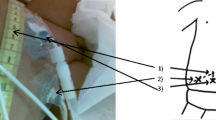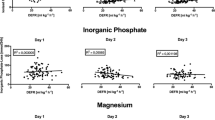Abstract
The impact of continous arteriovenous haemodiafiltration (CAVHD) on nitrogen, lipid and carbohydrate balance was studied in 9 parenterally fed critically ill patients with acute renal failure. The effects on carbohydrate delivery of varying dialysate glucose concentrations or flow rates were also investigated. The total daily nitrogen loss was a mean of 24.1 g (95% CI 20.9–27.3 g/24 h) with non-urea nitrogen losses of 7.6 g (95% CI 5.6–9.6 g/24h). Glucose delivery was a mean 5.8 g/h with a dialysate glucose concentration of 1.5% and a flow rate of 1l/h (95% CI 4.5–7.0 g/h). Carbohydrate delivery increased with increased dialysate glucose concentration (mean 11.4 g/h with 2.5% glucose: 95% CI 9.6–13.1 g/h; mean 14.9 g/h with a 4.25% concentration: 95% CI 10.9–19; and with increased dialysate flow rates (mean 9.6 g/h, 95% CI 6.8–12.4 g/h, using 2 l/h of 1.5% glucose). Only trace amounts of cholesterol and/or triglycerides were detected in occasional ultradiafiltrate samples. CAVHD has an important impact on nitrogen and carbohydrate balance, but not on lipid status. Knowledge of these interactions is crucial for the rational planning of nutritional strategies in the critically ill.
Similar content being viewed by others
References
Kramer P, Wigger W, Rieper J, Matthaei D, Scheler F (1977) Arteriovenous hemofiltration: a new and simple method for treatment of overhydrated patients resistant to diuretics. Klin Wochenschr 55:1121–1122
Geronemus R, Schneider N (1984) Continuous arteriovenous hemodialysis. A new modality for the treatment of acute renal failure. Trans Am Soc Artif Intern Organs 230:610–612
Stevens PE, Davies SP, Brown AA, Riley B, Gower PE, Knox W (1988) Continuous arteriovenous hemodialysis in critically ill patients. Lancet II:150–152
Bellomo R, Ernest D, Love J, Parkin G, Boyce N (1990) Continuous arteriovenous haemodiafiltration: Optimal therapy for acute renal failure in an intensive care setting. Aust NZ J Med 20:237–242
Pattison ME, Lee SM, Ogden DA (1988) Continuous arteriovenous hemodiafiltration: an aggressive approach to the management of acute renal failure. Am J Kidney Dis 11:43–47
Iapichino G, Gattinoni L, Solca M et al (1982) Protein sparing and protein replacement in acutely injured patients during TPN with and without amino acid supply. Intensive Care Med 8:25–31
Davenport A, Roberts NB (1989) Amino acid losses during continuous high-flux hemofiltration in the critically ill patient. Crit Care Med 17:1010–1014
Cerra FB, Holman RT, Bankey PE, Bazuski JE (1990) Nutritional pharmacology: its role in the hypermetabolism-organ failure syndrome. Crit Care Med 18:5154–5158
Cerra FB (1987) Hypermetabolism, organ failure and metabolic support. Surgery 101:1–14
Iapichino G, Radrizzani D, Solca M et al (1984) The main determinants of nitrogen balance during total parenteral nutrition in critically ill injured patients. Intensive Care Med 10:251–254
Cerra F, Blackburn G, Hirsh J et al (1987) The effect of stress level, amino acid formula and nitrogen dose on nitrogen retention in traumatic and septic stress. Ann Surg 205:282–288
Birkhan R, Long C, Fitkin D, Geiger J, Blakemore W (1980) Effects of major skeletal trauma on whole body protein turnover in man measured by 1, 14C leucine. Surgery 88:294–297
Moyer F, Border JR, McMenamy R, Cerra F (1981) Multiple systems organ failure V: alterations in plasma protein profile in septictrauma-effect of intravenous amino acids. J Trauma 21:645–649
Heidland A, Schaefer RM, Heidbreder E, Horl WA (1988) Catabolic factors in renal failure: therapeutic approaches. Nephrol Dial Transplant 3:8–16
Daly JM, Reynolds J, Sigal RK, Show J, Liberman MD (1990) Effect of dietary protein and amino acids on immune function. Crit Care Med 18:586–593
Bouffard Y, Viale JP, Annat G, Delafosse B, Guillame C, Motin J (1987) Energy expenditure in the acute renal failure patient mechanically ventilated. Intensive Care Med 13:401–404
Author information
Authors and Affiliations
Rights and permissions
About this article
Cite this article
Bellomo, R., Martin, H., Parkin, G. et al. Continuous arteriovenous haemodiafiltration in the critically ill: Influence on major nutrient balances. Intensive Care Med 17, 399–402 (1991). https://doi.org/10.1007/BF01720677
Received:
Accepted:
Issue Date:
DOI: https://doi.org/10.1007/BF01720677




